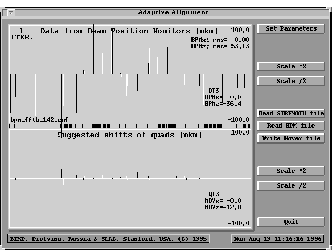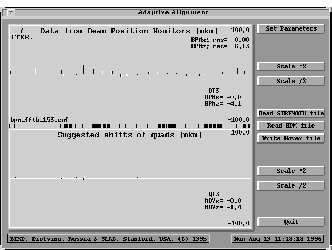The first results of the experiment on the beam-based
adaptive alignment of the magnetic elements of linear colliders
are given in this report. This experiment has been realized on
the Stanford Linear Collider at SLAC (USA) at the FFTB facility
and showed the good convergence and stability of the method. It
can be applied to compensate as any sharp or fluent technical
displacement of quads as the seismic vibrations of the ground.
One of the greatest challenges to the development of TeV-scale e+e- linear colliders is to make particle beams with extremely small sizes up to few tens nanometers. Producing and colliding tightly focused beams requires careful control, precise alignment and stabilization of magnetic elements. The demands to precision of alignment could be from few microns till to some nanometers. However, seismic movement of the ground, technical noise and many other reasons leads to destruction of the alignment and makes our efforts to do alignment one time forever absolutely useless. Therefore, the alignment should be only adaptive, which operates simultaneously with the operating of the accelerator.
The proposed algorithm of adaptive alignment [1] is an iterative process and consists of following steps. Each quad has the beam position monitor (BPM). To shift the certain lens the method requires BPM's data from this quad and two neighboring ones (i.e. algorithm is local).
Then suggested shifts for each quad can be calculated
by following formula:
where dE/E - beam energy spread,
- data from BPM of the quad
number i;
L1 - distance to the previous quad;
L2 - distance to the next quad;
- length of the quad number
i;
- reverse focusing distance
of the quad;
- coefficient, which takes
into account the differences of the real optics from the thin
lens approximation.
In each iterative step suggested shifts should be calculated for all quads, and then all of them should be moved simultaneously. The movement can be realized as by the shifting of the quad itself, as by changing of the magnetic field configuration with help of special additional coils.
This algorithm smoothes the sharp thrustes very fastly,
and more slowly - the fluent ones.
The method has been tested experimentally on the Stanford Linear Collider at SLAC.
For the first, the independence of the method from the beam oscillations was checked. For that aim two sets of suggested shifts of quads was calculated. One for normal beam passing and second - after forced deflection of the beam in vertical direction, which have leaded to the big beam oscillations. In the both cases the calculated shifts of quads were very similar. It means that the algorithm of adaptive alignment is sensitive only to the real displacement of quads, but not to the beam oscillations.
After that, the algorithm was applied to the final
focus of operating accelerator to improve it alignment.

The figure 1 shows the initial behavior of the beam,
and figure 2 - it oscillations after 7 iterations of the adaptive
alignment algorithm.

It can be seen that after the procedure of adaptive
alignment the beam reduced its oscillations about 10 times. The
suggested shifts are about zero. It means that the quads are in
practically strait line.
It was experimentally confirmed that the method of adaptive alignment works enough fastly and properly and can be applied to compensate as any sharp or fluent technical displacements of quads as the seismic vibrations of the ground.
The Adaptive Alignment is a convergent process even
the BPM's null-calibrations errors take place.[2]
[1] V.Balakin "Adaptive Structure VLEPP",
Proc of 3rd Intern. Workshop on Next Generation Linear Collider
LC91, Protvino, (1991).
[2] A.Sery, A.Mosnier "Spectral Analysis of Alignment Techniques for Linear Colliders" Submitted to Nuclear Instruments and Methods in Physics Research A. (1996)